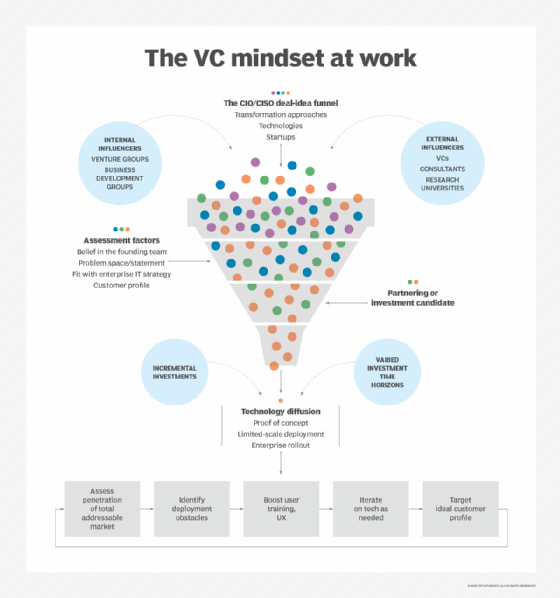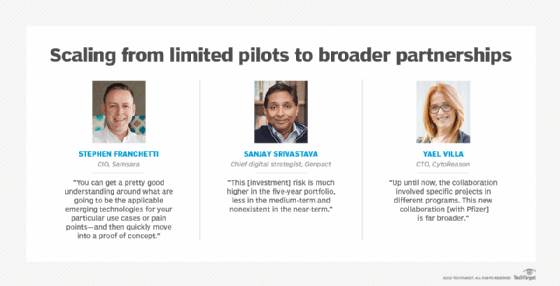Technology diffusion strategies for CIOs and the VC mindset (original) (raw)
Venture capital thinking was a matter of geographical destiny for Samsara, an industrial IoT company with headquarters in San Francisco.
"We naturally kind of take on this VC mindset," said Stephen Franchetti, CIO at Samsara. "We live in an area of the country where there are a lot of VCs focused on emerging technologies, so relationships with those VCs and networks of other CIOs become really important."
Familiarity has bred success in Samsara's case. Meeting periodically with VCs, and other external partners, helps the company stay on top of fields from security to AI, Franchetti noted. Discussions with VCs also help Samsara understand which startups in an investor's portfolio best suit its needs. This helps populate an ideation funnel, consisting of startups and technology approaches. The company can then select the most promising offerings for its business needs and prepare for initial testing and technology diffusion -- the process by which a technology spreads within an enterprise.
"You can get a pretty good understanding around what are going to be the applicable emerging technologies for your particular use cases or pain points -- and then quickly move into a proof of concept," Franchetti said.
VC thinking in technology diffusion
While VC thinking influences the funnel and the startup shortlist, it can also play a role in the technology diffusion phase. This process often begins with a POC, moves on to a limited deployment and, if all goes well, a large-scale rollout.
Technology diffusion is where risk versus reward comes into sharper focus. Make the right investment decision and the payoffs can propel a company well ahead of its rivals. An Accenture study found that digital leaders grow at five times the pace of digital laggards. But technology ventures can also miss the mark.
"Just in talking to IT executives, you always come across large programs that have gone down in flames," said Tony Olzak, CTO at Trace3, a consulting firm in Irvine, Calif.
Millions of dollars and multiple years are poured into massive endeavors that fail, spectacularly. Instead, CIOs need to "keep the blast radius small," Olzak said.
Keep the blast radius small.
Tony OlzakCTO, Trace3
Following a path similar to a startup's rounds of funding, organizations should start small and expand stepwise as the technology proves itself. That trajectory starts with seed capital, progresses to increasing levels of investment over Series A, B, C rounds and continues on to a liquidity event such as an IPO or acquisition.
"Start with this very focused problem in a way that you're attacking it with the least amount of money possible," Olzak advised technology managers. If things work out, they can move on to the successive rounds of funding.
Another dimension of the VC portfolio approach is time. CIOs might allocate their technology outlays according to one-year, two-year and five-year investment horizons, for example, noted Sanjay Srivastava, chief digital strategist at Genpact, a professional services firm based in New York. Eighty percent of funding could be assigned to near-to-medium-term investments, with 20% reserved for longer-term investments.
'This [investment] risk is much higher in the five-year portfolio, less in the medium-term and nonexistent in the near-term," he said.

Tech diffusion, done well, brings the ideation funnel to fruition.
Pfizer's expanding startup partnership, investment
The relationship between pharmaceutical giant Pfizer and Israeli startup CytoReason, demonstrates this stepwise progression. Pfizer entered an agreement with CytoReason, a Tel Aviv company that develops computational disease models, to work together on the preclinical development of a drug.
Pfizer had to target a disease that would be a good candidate for a drug under development. The startup's scientists analyzed multiple comparisons in its database, assessing a variety of diseases, said Yael Villa, CTO at CytoReason. The process of finding the best fit took a couple of months, Villa said, noting that the process would typically take a couple of years.
That project helped pave the way for a 2019 collaboration agreement, which CytoReason described at the time as potentially worth "double-digit millions" of dollars. In September 2022, Pfizer unveiled an expanded agreement to use CytoReason's AI technology for its drug development programs. The updated relationship, which also involves a 20millionequityinvestment,couldbeworthasmuchas20 million equity investment, could be worth as much as 20millionequityinvestment,couldbeworthasmuchas110 million over the next five years -- Pfizer has options to license CytoReason's AI platform and disease models during that time span.
Pfizer's Emerging Science Leads, a team of Ph.Ds and medical doctors, looks for partnering opportunities within academia and the biotechnology industry, evaluating matches for Pfizer's R&D organizations, a company spokesperson said. The R&D teams "have been strategically focused on artificial intelligence, as well as cultivating partnerships," the spokesperson added.
Identifying ideal customers, markets to foster diffusion
The stages of technology diffusion and investment should also take customers and markets into account. Startups with a fuzzy view of their buyers will likely develop products that miss their needs. VCs ask investment candidates about their ideal customer profile (ICP) and CIOs and CISOs might consider that same question when dealing with emerging technology startups.
Cybersecurity startups, for example, tend to create products that "solve problems in a more difficult way," said Ross Hosman, a CISO who has been advising early stage companies as part of Silicon Valley CISO Investments, an angel investor group. But startups would be better off focusing on one simple, day-to-day CISO problem -- rather than boil the proverbial ocean, he noted.
"One of my questions to every company is, what's your ICP?" Hosman noted. "Let's make sure we're building the product to that."
Ensuring a fit between product and use case is one thing but following through on adoption can prove quite another. At Samsara, Franchetti said he thinks about technology diffusion in terms of the total addressable market (TAM). That approach puts the CIO in the role of a general manager, with an enterprise's user-customers becoming the market.
"What's the total user population we're actually targeting?" Franchetti asked. "I think a lot of IT organizations miss this step. We're constantly focused on certain technical aspects of deploying technology and then we move on to the next project versus, how do we actually make that technology deployment successful? How do we make that stick within that total addressable market?"

Gauging market penetration
Understanding the TAM is the first step. Next, the IT team should determine the technology's market penetration after the initial deployment and over time. If the market penetration is only 5% or 10%, technology managers can start focusing on the obstacles that prevent wider adoption, Franchetti said. Organizations can then offer training or improve the user experience to spark the technology's acceptance.
"There are some technologies that are more complex in nature that are going to need some degree of training," Franchetti said.
But Franchetti said he believes the user experience is the most important aspect of technology deployment.
"IT organizations live and die on the strength of the user experience associated with the services that they produce," he said. "And we, as an IT organization, need to take an active role and owning that experience.